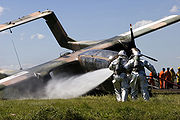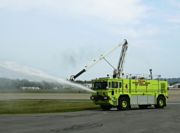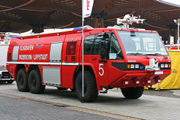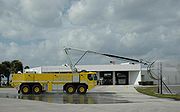
Aircraft Rescue and Firefighting
Encyclopedia


Aircraft
An aircraft is a vehicle that is able to fly by gaining support from the air, or, in general, the atmosphere of a planet. An aircraft counters the force of gravity by using either static lift or by using the dynamic lift of an airfoil, or in a few cases the downward thrust from jet engines.Although...
involved in (typically) an airport ground emergency.
Airports may have regulatory oversight by an arm of their individual national governments or voluntarily under standards of the International Civil Aviation Organization
International Civil Aviation Organization
The International Civil Aviation Organization , pronounced , , is a specialized agency of the United Nations. It codifies the principles and techniques of international air navigation and fosters the planning and development of international air transport to ensure safe and orderly growth...
.
Due to the mass casualty potential of an aviation emergency, the speed with which emergency response equipment and personnel arrive at the scene of the emergency is of paramount importance. Their arrival and initial mission to secure the aircraft against all hazards, particularly fire, increases the survivability of the passengers and crew on board. Airport firefighters have advanced training in the application of firefighting foams, dry chemical and clean agents used to extinguish burning aviation fuel
Aviation fuel
Aviation fuel is a specialized type of petroleum-based fuel used to power aircraft. It is generally of a higher quality than fuels used in less critical applications, such as heating or road transport, and often contains additives to reduce the risk of icing or explosion due to high temperatures,...
in and around an aircraft in order to maintain a path for evacuating passengers to exit the fire hazard area. Further, should fire either be encountered in the cabin or extend there from an external fire, the ARFF responders must work to control/extinguish these fires as well.
Apparatus

Personal protective equipment
Due to the intense radiant heat generated by burning fuels, firefighters wear protective ensembles that are coated with a silvered material to reflect heat away from their bodies, called a fire proximity suitFire proximity suit
A fire proximity suit is a suit designed to protect a firefighter from high temperatures, especially near fires of extreme temperature such as aircraft fires....
. They also must wear self-contained breathing apparatus to provide a source of clean air, enabling them to work in the presence of smoke or other super-heated gases, such as when making entry into the burning cabin of an aircraft.
Secondary to the hazard mitigation and safe evacuation of ambulatory passengers is the need to perform rescue operations
Rescue
Rescue refers to responsive operations that usually involve the saving of life, or prevention of injury during an incident or dangerous situation....
. Passengers unable to extricate themselves must be removed from the aircraft and provided medical care. This process is extremely labor-intensive, requiring both firefighters and support personnel. Due to the nature of a mass casualty incident, rescue workers employ triage
Triage
Triage or ) is the process of determining the priority of patients' treatments based on the severity of their condition. This rations patient treatment efficiently when resources are insufficient for all to be treated immediately. The term comes from the French verb trier, meaning to separate,...
to classify the victims and direct their efforts where they can best affect survival.
Subsequent to the emergency being declared under control, the ARFF function reverts to one of protecting the scene, eliminating any peripheral or slowly evolving hazards and assisting to preserve the scene for investigators. In many cases the FAA will perform the investigatory duties but in instances where significant injuries or any fatal accident the National Transportation Safety Board
National Transportation Safety Board
The National Transportation Safety Board is an independent U.S. government investigative agency responsible for civil transportation accident investigation. In this role, the NTSB investigates and reports on aviation accidents and incidents, certain types of highway crashes, ship and marine...
(NTSB) will investigate and the ARFF contingent will assist where needed.
ARFF in the United States

Federal Aviation Administration
The Federal Aviation Administration is the national aviation authority of the United States. An agency of the United States Department of Transportation, it has authority to regulate and oversee all aspects of civil aviation in the U.S...
(FAA) mandates ARFF operations at all U.S. airports that serve scheduled passenger air carriers. These are the only civilian fire protection services that are specifically regulated by any governmental entity.
Airports required to have ARFF services are inspected at least annually by the FAA for compliance with FAR, Part 139. Military ARFF operations must meet the mission requirements for their individual branch of the service.
Airport index
An index is assigned to each FAA Part 139 certificate holder based on a combination of the air carrier aircraft length and the average number of daily departures. If the longest air carrier aircraft at the airport has five or more average daily departures, the matching index is used. If the longest aircraft has less than five average daily departures, the next lower index is used. That index determines the required number of ARFF vehicles and required amount of extinguishing agents.| Index | Aircraft length | Vehicles | Extinguishing agents |
|---|---|---|---|
| A | 1 | either 500 pounds of sodium-based dry chemical, halon 1211, or clean agent; or 450 pounds of potassium-based dry chemical and water with a commensurate quantity of AFFF to total 100 gallons for simultaneous dry chemical and AFFF application. | |
| B | 1 | 500 pounds of sodium-based dry chemical, halon 1211, or clean agent and 1,500 gallons of water and the commensurate quantity of AFFF for foam production | |
| 2 | one vehicle carrying the extinguishing agents as specified for Index A; and one vehicle carrying an amount of water and the commensurate quantity of AFFF so the total quantity of water for foam production carried by both vehicles is at least 1,500 gallons. | ||
| C | 2 | one vehicle carrying the extinguishing agents as specified for Index B; and one vehicle carrying water and the commensurate quantity of AFFF so the total quantity of water for foam production carried by both vehicles is at least 3,000 gallons | |
| 3 | one vehicle carrying the extinguishing agents as specified for Index A; and two vehicles carrying an amount of water and the commensurate quantity of AFFF so the total quantity of water for foam production carried by all three vehicles is at least 3,000 gallons | ||
| D | 3 | one vehicle carrying the extinguishing agents as specified for Index A; and two vehicles carrying an amount of water and the commensurate quantity of AFFF so the total quantity of water for foam production carried by all three vehicles is at least 4,000 gallons | |
| E | 3 | one vehicle carrying the extinguishing agents as specified for Index A; and two vehicles carrying an amount of water and the commensurate quantity of AFFF so the total quantity of water for foam production carried by all three vehicles is at least 6,000 gallons |

